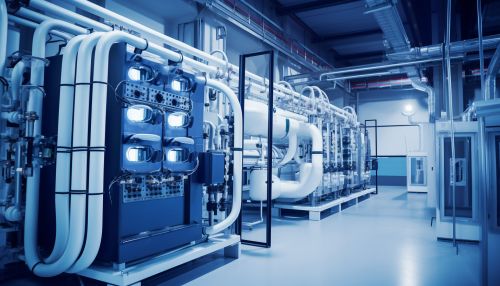Electrodialysis
Introduction
Electrodialysis (ED) is a membrane process, during which ions are transported through semi-permeable membranes, from one solution towards another, under the influence of a voltage potential gradient. This technology is used in many industrial processes, including water purification, desalination, dairy product creation, and waste treatment.
Principle of Operation
The principle of operation of electrodialysis is based on the movement of ions between two solutions under the influence of an electric field. This movement is facilitated by the use of ion-selective membranes, which allow only certain ions to pass through. The membranes are arranged in a stack with alternating cation and anion selective membranes. The solutions that flow between the membranes are called dilute (the solution from which ions are removed) and concentrate (the solution to which ions are transferred).
Components of an Electrodialysis System
An electrodialysis system consists of several key components, including the electrodialysis stack, power supply, and solution feed and disposal systems.
Electrodialysis Stack
The electrodialysis stack is the heart of the system. It consists of a series of cation and anion selective membranes, arranged in alternating order. The stack also includes a number of spacers, which serve to separate the membranes and create flow channels for the solutions.
Power Supply
The power supply provides the electric field necessary for the operation of the system. It is typically a direct current (DC) power supply, with the ability to provide a stable and adjustable voltage.
Solution Feed and Disposal Systems
The solution feed system provides the dilute and concentrate solutions to the electrodialysis stack. The disposal system collects the processed solutions from the stack and disposes of them in an appropriate manner.
Applications of Electrodialysis
Electrodialysis has a wide range of applications in various industries.
Water Purification and Desalination
One of the most common applications of electrodialysis is in the field of water purification and desalination. It is used to remove salts and other impurities from water to make it suitable for drinking or industrial use.
Dairy Industry
In the dairy industry, electrodialysis is used to concentrate milk and whey. This process increases the protein content of these products, making them more valuable.
Waste Treatment
Electrodialysis is also used in waste treatment processes. It can be used to remove harmful ions from waste streams, making them safer for disposal.
Advantages and Disadvantages of Electrodialysis
Like any technology, electrodialysis has both advantages and disadvantages.
Advantages
One of the main advantages of electrodialysis is its ability to selectively remove ions from solutions. This makes it a highly effective method for water purification and desalination. Additionally, electrodialysis is a continuous process, which can be a significant advantage in industrial applications.
Disadvantages
On the downside, electrodialysis systems can be expensive to install and operate. They also require a significant amount of energy, which can be a disadvantage in areas where energy costs are high.
See Also


